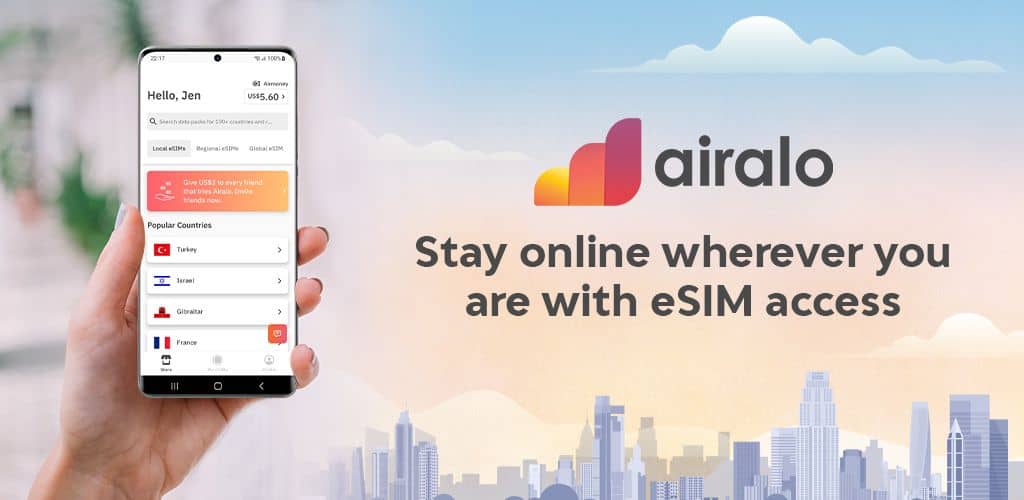Last updated on January 28th, 2024 at 03:14 am

Bytesim vs Airalo eSIM – While Airalo offers flexibility with its pay-as-you-go plans, Bytesim provides better value for longer trips with unlimited data plans. In this post, we share more about eSIMs and what they really are, comparing Bytesim vs Airalo eSIM and the plans you can choose from.
As technology advances, the way we travel and stay connected is continually evolving. One innovation that has taken the telecommunications industry by storm is the eSIM or embedded SIM.
This tiny chip embedded in your smartphone, smartwatch, or tablet allows you to switch between mobile networks seamlessly without the need for a physical SIM card.
Read here best eSim for Europe and the best eSim for International Travel
Related Travel Guides – Bytesim vs Airalo eSIM
- Bytesim Full Review – Is this the Right eSIM Choice for You?
- Airalo vs Holafly – Which is the Better eSIM
- Airalo vs BNESIM – Which is the Better eSIM
- Bytesim vs Ubigi
What is an eSIM?
An eSIM is an embedded SIM card that is built into your device, allowing you to switch between mobile network operators without having to swap out physical SIM cards. This makes it an incredibly convenient option for travelers, as it eliminates the need to carry multiple SIM cards or purchase new ones upon arrival in a foreign country. Instead, users can simply select and purchase a data plan from a local carrier through an app or website, and the eSIM will be activated automatically.
Before you go into eSIM, you’ll have to know if your device is eSIM compatible.
Phones with eSIM
iOS Phones / iPhones
- iPhone XR
- iPhone XS
- iPhone XS Max
- iPhone 11
- iPhone 11 Pro
- iPhone SE 2 (2020)
- iPhone 12
- iPhone 12 Mini
- iPhone 12 Pro
- iPhone 12 Pro Max
- iPhone 13
- iPhone 13 Mini
- iPhone 13 Pro
- iPhone 13 Pro Max
- iPhone SE 3 (2022)
- iPhone 14
Samsung with eSIM
- Samsung Galaxy S20
- Samsung Galaxy S20+
- Samsung Galaxy S20 Ultra
- Samsung Galaxy S21
- Samsung Galaxy S21+ 5G
- Samsung Galaxy S21+ Ultra 5G
- Samsung Galaxy S22
- Samsung Galaxy S22+
- Samsung Galaxy S22 Ultra
- Samsung Galaxy Note 20
- Samsung Galaxy Note 20 Ultra 5G
- Samsung Galaxy Fold
- Samsung Galaxy Fold 3
- Samsung Galaxy Z Fold2 5G
- Samsung Galaxy Z Fold3 5G
- Samsung Galaxy Z Flip3 5G
- Samsung Galaxy Z Flip3 5G Fold
- Samsung Galaxy Z Flip
- Samsung Watch (via Samsung Wearable application)
Google Pixel Esim Phones
Have a Google Pixel phone, check this guide on how to activate eSIM. Below are the Google Pixel Phones that support eSIM:
Google Pixel 2 (only phones bought with Google Fi service), Google Pixel 2 XLGoogle Pixel 3, Google Pixel 3 XL, Google Pixel 3a, Google Pixel 3a XL, Google Pixel 4, Google Pixel 4a, Google Pixel 4 XL, Google Pixel 5, Google Pixel 5a, Google Pixel 6, Google Pixel 6 Pro.
Other Android Handsets that Support the eSIM functionality:
Huawei P40, Huawei P40 Pro, Huawei Mate 40 Pro
Oppo Find X3 Pro, Oppo Reno 5A, Oppo Reno6 Pro 5G, Oppo Find X5, Oppo Find X5 Pro, Oppo A55s
Motorola Razr 2019, Motorola Razr 5G, Nuu Mobile X5, Gemini PDA, Rakuten Mini, Rakuten Big-S, Rakuten Big and Sony Xperia 10 III Lite.
There are also Ultrabooks that have eSIM functionality in them.
So check the following ultrabooks and laptops:
Microsoft Surface Pro X, Microsoft Surface Go 2, Microsoft Surface Pro LTE Advanced
Acer Swift 3, Acer Swift 7, Asus Mini Transformer
Asus NovaGo, Asus VivoBook Flip 14, HP Elitebook G5
HP Probook G5, HP Zbook G5, HP Specter Folio 13, Lenovo Yoga C630, Lenovo Miix 630
Lenovo Yoga 520, Lenovo Flex 5G and Samsung Galaxy Book 2
eSIM vs SIM Cards
Traditional SIM cards have been the standard for mobile connectivity for many years. However, eSIMs are quickly gaining popularity due to their numerous advantages. Some key differences between eSIMs and traditional SIM cards include:
Convenience
eSIMs eliminate the need for physical SIM cards, making it easier to switch between carriers or plans, especially when traveling.
Space-saving
With eSIMs, device manufacturers can free up space within the device, allowing for thinner and lighter designs.
Environmentally friendly
eSIMs reduce the need for plastic SIM card production, lowering the environmental impact of mobile devices.
Comparing Bytesim vs Airalo eSIM
To provide a comprehensive comparison between esims Bytesim vs Airalo, we’ll evaluate both providers across various elements.
Is Bytesim better than Airalo?
Comparing the two, Bytesim stands out in a lot of its offered features:
- Bytesim offers unlimited data plans, whereas Airalo may have data limits.
- For destination countries, Bytesim offers more flexible and diverse single-purpose plans compared to Airalo.
- Bytesim offers a unique press daily billing package, whereas Airalo only offers total packages.
- Bytesim provides simultaneous coverage of multiple operators in a single area, and customers can switch operators freely.
Coverage

Bytesim eSIM
Bytesim offers coverage in over 200 countries and regions, ensuring that you stay connected almost anywhere you travel.
Airalo
Airalo provides coverage in over 190 countries, also offering a vast global reach.

Pricing and Plans
Overview of Bytesim eSIM Plans
Byte eSIM offers a variety of plans designed to cater to different travel needs. While the plans may vary based on the destination, data allowance, and duration, here are some examples of plans available through Byte eSIM:
a. Regional Plans
These plans are designed for travelers visiting specific regions, such as Europe, Asia, or North America. Regional plans typically come with a larger data allowance and cover multiple countries within the selected region.
When you purchase your eSIM prepaid plan with Bytesim, you’ll have options to choose the amount of data you want to use, and for how long you want your data available. Prices are competitive and comparable to local sim card rates.
One example is their Global Data plan for 86 countries around the world, with prices starting from $15 for 300MB/day for 3 days.
b. Country-Specific Plans
Country-specific plans are tailored to individual countries, providing coverage and data allowance specifically for the selected destination. These plans can range from smaller data allowances to larger allowances, depending on the traveler’s needs.
For example, prices for data in the US plans start at $4.90, for 500MB per day for 3 days.
High speed( 5G/ LTE) data plan,
Unlimited 128kbps afterward.
It’s essential to note that the availability of plans and pricing may vary depending on the destination and user’s location. To get the most accurate and up-to-date information on plans and pricing, it is recommended to check the Bytesim eSIM app or website.
Airalo
Airalo also offers a variety of plans, including regional and country-specific options. Prices are generally affordable, but the exact cost will depend on the destination and the chosen plan.
Ease of Use
Bytesim eSIM
The Bytesim app is user-friendly, allowing you to quickly browse and purchase plans. The app also provides a clear overview of your remaining data and plan expiration.
Airalo
Airalo’s platform is equally easy to use, with a straightforward process for selecting and purchasing plans. The platform also provides a summary of your active plans and remaining data.
Customer Support
Bytesim eSIM: Bytesim offers customer support via email and a dedicated help center, where you can find answers to frequently asked questions.
Airalo: Airalo provides customer support through email and an extensive knowledge base on their website, ensuring that you have access to the information you need.
Device Compatibility
Both Bytesim eSIM and Airalo are compatible with a wide range of eSIM-enabled devices, including popular smartphones like the iPhone, Samsung Galaxy, and Google Pixel, as well as smartwatches and tablets.
Final Thoughts on Bytesim vs Airalo eSIM
Bytesim eSIM and Airalo both offer extensive coverage, affordable plans, and user-friendly platforms, making them excellent choices for travelers looking for a reliable eSIM solution. While Airalo has a wide range of eSIMs tailored for different regions, Bytesim offers simpler global plans that may be more suitable for those who travel to multiple regions.
When considering which provider to choose, it’s essential to consider factors such as your destination, desired data allowance, and the duration of your trip. Additionally, you may want to compare the plans available for your specific device, as compatibility can vary.
For this competition, we use Bytesim. Tell us what you ended up choosing and let us know if you have any questions.
About the Author: Ruben, co-founder of Gamintraveler.com since 2014, is a seasoned traveler from Spain who has explored over 100 countries since 2009. Known for his extensive travel adventures across South America, Europe, the US, Australia, New Zealand, Asia, and Africa, Ruben combines his passion for adventurous yet sustainable living with his love for cycling, highlighted by his remarkable 5-month bicycle journey from Spain to Norway. He currently resides in Spain, where he continues sharing his travel experiences with his partner, Rachel, and their son, Han.
